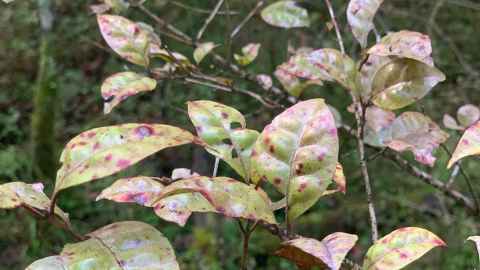Ngārara in the Raukumara
1 November 2021
A new documentary lays bare the distress and urgency felt by environmental kaitiaki, as myrtle rust compounds an already precarious situation for threatened native species.

Mate Tipu, Mate Rākau follows Department of Conservation Ranger Graeme Atkins (Ngāti Porou, Rongomaiwahine), as he reveals the rapid devastation that the airborne fungal pathogen myrtle rust (Austropuccinia psidii) is having on the East Coast.
The 9-minute documentary, produced and directed by videographer Fiona Apanui-Kupenga (Ngāti Porou) and her team at Te Amokura Productions, is one of the first creative projects commissioned by Toi Taiao Whakatairanga, a cross-disciplinary collaborative research project hosted by Creative Arts and Industries at the University of Auckland. The project brings together arts, science and Te Ao Māori, to raise awareness of biological threats to our ngahere and wider ecological systems.
Over three years the project is commissioning Māori artists to develop new public artwork through creative engagement with iwi, hapū and community across areas impacted by two invasive plant pathogens - kauri dieback disease (Phytopthora agathidicida) and myrtle rust.
“This project aims to engage with how public arts practices can cultivate and grow public awareness and positive action to do with kaitiakitanga, caring for and respecting the mana of our ngahere/forests”, says project lead, Dr Mark Harvey (Mātāwaka) senior lecturer, Faculty of Creative Arts and Industries.
Myrtle rust was first observed on mainland New Zealand in May 2017 and quickly outpaced Ministry for Primary Industry-led efforts to eradicate it. Atkins has been raising a red flag about the severity of myrtle rust impacts on native species, charting the impacts of the disease by sharing observations through social media networks, since his first sightings on ramarama trees in April 2018. In the documentary he warns that the risk of local extinction is acute.
“In three years, all the ramarama on the East Coast is gone….”
Apanui-Kupenga’s documentary was one of the first creative works commissioned by Toi Taiao Whakatairanga. Having previously worked closely with Atkins, including on Tihei Taiao, a series of online videos introducing viewers to species of native trees, she was familiar with the urgency of the situation for ramarama.
Designed as a call for urgent action, Mate Tipu, Mate Rākau hints at the potential for much wider ecological - and economic – collapse as other species are impacted. There are 15 species of native myrtle trees and plants (myrtaceae) in the region with increasing observations of myrtle rust, including on one of the most important economic crops for iwi in the region, mānuka. Other myrtles at risk as the disease spreads across the country include pōhutakawa, rata, maire and kānuka.
Toi Taiao Whakatairanga – Cultivating Kaitiakitanga Through Creative Practices
Toi Taiao Whakatairanga recognises the potential and role the arts have in promoting care for, the natural environment. “With previous creative projects undertaken to raise awareness on kauri dieback disease, I’ve seen first-hand how art can connect people emotionally to an issue, how arts-led projects can spark community education and make a safe space for cross-sector and community discussion”, says Toi Taiao Whakatairanga researcher, curator Ariane Craig-Smith.
By tracing the dynamics of interactions between communities, artists, scientists, mana whenua and others engaged in forest kaitiakitanga, Toi Taiao Whakatairanga also aims to demonstrate how artistic practices can engage with mātauranga Māori frameworks.
Other artists engaged in the first year of the project include designer Tyrone Ohia (Ngāti Pūkenga, Ngāi te Rangi) and visual artist Charlotte Graham (Hauraki, Waikato, Ngati Mahuta, Ngai Tai, Ngati Tamaoho). The project is also planning to work in Northland with Te Roroa iwi in collaboration with film and sound artist Danial Nathan. The project will run until 2023.
Toi Taiao Whakatairanga is funded by Mobilising for Action, a social science research theme of the Biological Heritage National Science Challenge, Ngā Rākau Taketake programme, which is also funding science research to understand myrtle rust disease and its impacts in New Zealand.
The Mobilising for Action research rōpū seek to make ‘on the ground difference’ to how kauri dieback and myrtle rust are being understood and addressed. Public knowledge and behaviour has a critical role both in informing this research and in developing management strategies, says Dr Harvey.
“Toi Taiao Whakatairanga is a cross-disciplinary group of people, who are finding different ways to use the creative arts, to raise people’s awareness and knowledge and positively influence their behaviour, which is central to developing effective myrtle rust management strategies.”
Collective Action to Counter Myrtle Rust
One direct action people can take is to record observations with a smartphone via the iNaturalist app. These reports are enabling researchers to build an increasingly detailed picture of myrtle rust spread, as well as build awareness among trampers, hunters, and other groups who are regularly out in the environment.
Localised reporting also shows how the disease is operating in different ways on different species. These observations are critical, not only to inform wider scientific and management responses, but the Toi Taiao Whakatairanga research team also suggest that localised solutions will be key to preserving and supporting native myrtaceae populations. “Iwi and hapū, with their specific mātauranga about these species and environments, and unique relationships with their whenua, are going to have a critical role in that process.”
As Graeme Atkins says, “A load shared is a load halved”.
Links
Toi Taiao Whakatairanga on Facebook
For more information on myrtle rust visit myrtlerust.org.nz
Information on Ngā Rakau Taketake and Mobilising for Action
Toi Taiao Whakatairanga research team:
Dr Nick Waipara (Rongawhakaata and Ngāti Ruapani ki Turanga),plant-pathologist, Plant and Food
Ariane Craig-Smith, curator, The Kauri Project
Chris McBride, curator, The Kauri Project
Dr Mark Harvey (Mātāwaka), artist, conservationist, curator, The University of Auckland
Sophie Jerram, curator, The University of Auckland, Victoria University
Dr Molly Mullen, community education researcher, University of Auckland
Chervelle Athena, PhD Candidate, AUT
Media contact
Margo White I Media adviser
DDI 09 923 5504
Mob 021 926 408
Email margo.white@auckland.ac.nz